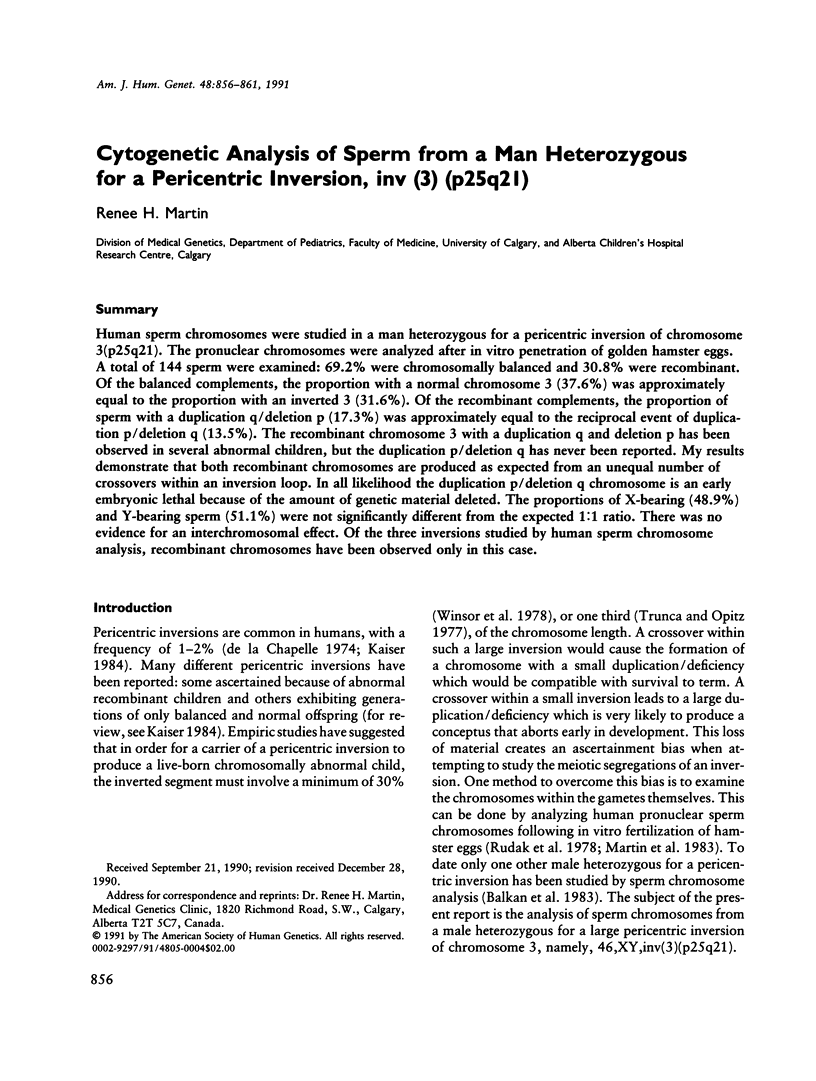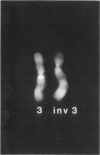Abstract
Human sperm chromosomes were studied in a man heterozygous for a pericentric inversion of chromosome 3(p25q21). The pronuclear chromosomes were analyzed after in vitro penetration of golden hamster eggs. A total of 144 sperm were examined: 69.2% were chromosomally balanced and 30.8% were recombinant. Of the balanced complements, the proportion with a normal chromosome 3 (37.6%) was approximately equal to the proportion with an inverted 3 (31.6%). Of the recombinant complements, the proportion of sperm with a duplication q/deletion p (17.3%) was approximately equal to the reciprocal event of duplication p/deletion q (13.5%). The recombinant chromosome 3 with a duplication q and deletion p has been observed in several abnormal children, but the duplication p/deletion q has never been reported. My results demonstrate that both recombinant chromosomes are produced as expected from an unequal number of crossovers within an inversion loop. In all likelihood the duplication p/deletion q chromosome is an early embryonic lethal because of the amount of genetic material deleted. The proportions of X-bearing (48.9%) and Y-bearing sperm (51.1%) were not significantly different from the expected 1:1 ratio. There was no evidence for an interchromosomal effect. Of the three inversions studied by human sperm chromosome analysis, recombinant chromosomes have been observed only in this case.
Full text
PDF





Images in this article
Selected References
These references are in PubMed. This may not be the complete list of references from this article.
- Allderdice P. W., Browne N., Murphy D. P. Chromosome 3 duplication q21 leads to qter deletion p25 leads to pter syndrome in children of carriers of a pericentric inversion inv(3) (p25q21). Am J Hum Genet. 1975 Nov;27(6):699–718. [PMC free article] [PubMed] [Google Scholar]
- Ashley T. G-band position effects on meiotic synapsis and crossing over. Genetics. 1988 Feb;118(2):307–317. doi: 10.1093/genetics/118.2.307. [DOI] [PMC free article] [PubMed] [Google Scholar]
- Balkan W., Burns K., Martin R. H. Sperm chromosome analysis of a man heterozygous for a pericentric inversion of chromosome 3. Cytogenet Cell Genet. 1983;35(4):295–297. doi: 10.1159/000131882. [DOI] [PubMed] [Google Scholar]
- Batanian J., Hulten M. A. Electron microscopic investigations of synaptonemal complexes in an infertile human male carrier of a pericentric inversion inv(1)(p32q42). Regular loop formation but defective synapsis including a possible interchromosomal effect. Hum Genet. 1987 May;76(1):81–89. doi: 10.1007/BF00283055. [DOI] [PubMed] [Google Scholar]
- Boué A., Gallano P. A collaborative study of the segregation of inherited chromosome structural rearrangements in 1356 prenatal diagnoses. Prenat Diagn. 1984 Spring;4(Spec No):45–67. doi: 10.1002/pd.1970040705. [DOI] [PubMed] [Google Scholar]
- Chandley A. C., McBeath S., Speed R. M., Yorston L., Hargreave T. B. Pericentric inversion in human chromosome 1 and the risk for male sterility. J Med Genet. 1987 Jun;24(6):325–334. doi: 10.1136/jmg.24.6.325. [DOI] [PMC free article] [PubMed] [Google Scholar]
- Fineman R. M., Hecht F., Ablow R. C., Howard R. O., Breg W. R. Chromosome 3 duplication q/deletion p syndrome. Pediatrics. 1978 Apr;61(4):611–618. [PubMed] [Google Scholar]
- Gabriel-Robez O., Ratomponirina C., Croquette M., Couturier J., Rumpler Y. Synaptonemal complexes in a subfertile man with a pericentric inversion in chromosome 21. Heterosynapsis without previous homosynapsis. Cytogenet Cell Genet. 1988;48(2):84–87. doi: 10.1159/000132595. [DOI] [PubMed] [Google Scholar]
- Gabriel-Robez O., Ratomponirina C., Croquette M., Maetz J. L., Couturier J., Rumpler Y. Reproductive failure and pericentric inversion in man. Andrologia. 1987 Nov-Dec;19(6):662–669. doi: 10.1111/j.1439-0272.1987.tb01924.x. [DOI] [PubMed] [Google Scholar]
- Gabriel-Robez O., Ratomponirina C., Rumpler Y., Le Marec B., Luciani J. M., Guichaoua M. R. Synapsis and synaptic adjustment in an infertile human male heterozygous for a pericentric inversion in chromosome 1. Hum Genet. 1986 Feb;72(2):148–152. doi: 10.1007/BF00283934. [DOI] [PubMed] [Google Scholar]
- Guichaoua M. R., Gabriel-Robez O., Ratomponirina C., Delafontaine D., Le Marec B., Taillemite J. L., Rumpler Y., Luciani J. M. Meiotic behaviour of familial pericentric inversions of chromosomes 1 and 9. Ann Genet. 1986;29(3):207–214. [PubMed] [Google Scholar]
- Kaiser P. Pericentric inversions. Problems and significance for clinical genetics. Hum Genet. 1984;68(1):1–47. doi: 10.1007/BF00293869. [DOI] [PubMed] [Google Scholar]
- Laurie D. A., Hultén M. A. Further studies on bivalent chiasma frequency in human males with normal karyotypes. Ann Hum Genet. 1985 Jul;49(Pt 3):189–201. doi: 10.1111/j.1469-1809.1985.tb01693.x. [DOI] [PubMed] [Google Scholar]
- Martin R. H., Balkan W., Burns K., Rademaker A. W., Lin C. C., Rudd N. L. The chromosome constitution of 1000 human spermatozoa. Hum Genet. 1983;63(4):305–309. doi: 10.1007/BF00274750. [DOI] [PubMed] [Google Scholar]
- Martin R. H., Rademaker A. W., Hildebrand K., Long-Simpson L., Peterson D., Yamamoto J. Variation in the frequency and type of sperm chromosomal abnormalities among normal men. Hum Genet. 1987 Oct;77(2):108–114. doi: 10.1007/BF00272374. [DOI] [PubMed] [Google Scholar]
- Martin R. H. Sperm chromosome analysis in a man heterozygous for a paracentric inversion of chromosome 7 (q11q22). Hum Genet. 1986 Jun;73(2):97–100. doi: 10.1007/BF00291594. [DOI] [PubMed] [Google Scholar]
- Martin R. H., Templado C., Ko E., Rademaker A. Effect of culture conditions and media on the frequency of chromosomal abnormalities in human sperm chromosome complements. Mol Reprod Dev. 1990 Jun;26(2):101–104. doi: 10.1002/mrd.1080260202. [DOI] [PubMed] [Google Scholar]
- Rudak E., Jacobs P. A., Yanagimachi R. Direct analysis of the chromosome constitution of human spermatozoa. Nature. 1978 Aug 31;274(5674):911–913. doi: 10.1038/274911a0. [DOI] [PubMed] [Google Scholar]
- Saadallah N., Hultén M. EM investigations of surface spread synaptonemal complexes in a human male carrier of a pericentric inversion inv(13)(p12q14): the role of heterosynapsis for spermatocyte survival. Ann Hum Genet. 1986 Oct;50(Pt 4):369–383. doi: 10.1111/j.1469-1809.1986.tb01758.x. [DOI] [PubMed] [Google Scholar]
- Sherman S. L., Iselius L., Gallano P., Buckton K., Collyer S., DeMey R., Kristoffersson U., Lindsten J., Mikkelsen M., Morton N. E. Segregation analysis of balanced pericentric inversions in pedigree data. Clin Genet. 1986 Aug;30(2):87–94. doi: 10.1111/j.1399-0004.1986.tb00575.x. [DOI] [PubMed] [Google Scholar]
- Trunca C., Opitz J. M. Pericentric inversion of chromosome 14 and the risk of partial duplication of 14q (14q31 leads to 14qter). Am J Med Genet. 1977;1(2):217–228. doi: 10.1002/ajmg.1320010208. [DOI] [PubMed] [Google Scholar]
- Winsor E. J., Palmer C. G., Ellis P. M., Hunter J. L., Ferguson-Smith M. A. Meiotic analysis of a pericentric inversion, inv(7) (p22q32), in the father of a child with a duplication-deletion of chromosome 7. Cytogenet Cell Genet. 1978;20(1-6):169–184. doi: 10.1159/000130849. [DOI] [PubMed] [Google Scholar]
- de Perdigo A., Gabriel-Robez O., Rumpler Y. Correlation between chromosomal breakpoint positions and synaptic behaviour in human males heterozygous for a pericentric inversion. Hum Genet. 1989 Oct;83(3):274–276. doi: 10.1007/BF00285171. [DOI] [PubMed] [Google Scholar]
- de la Chapelle A., Schröder J., Stenstrand K., Fellman J., Herva R., Saarni M., Anttolainen I., Tallila I., Tervilä L., Husa L. Pericentric inversions of human chromosomes 9 and 10. Am J Hum Genet. 1974 Nov;26(6):746–766. [PMC free article] [PubMed] [Google Scholar]




